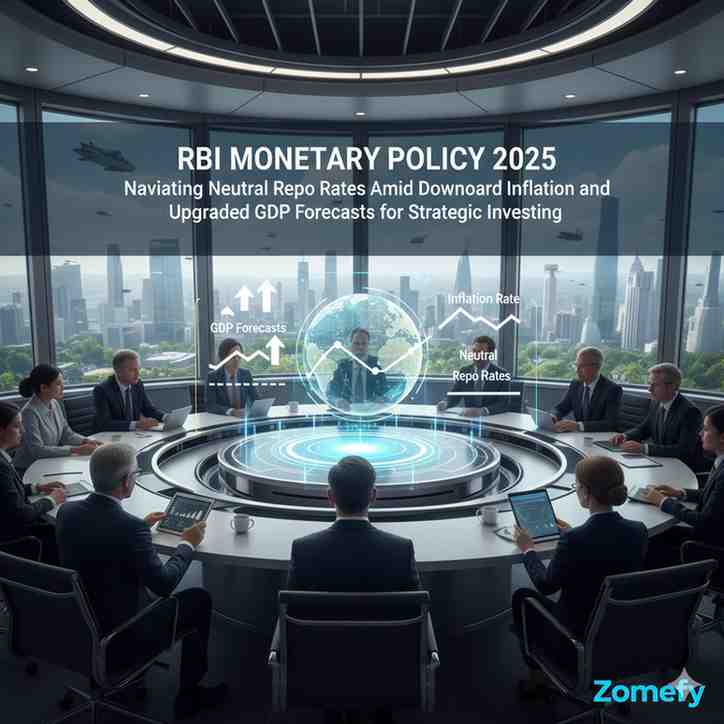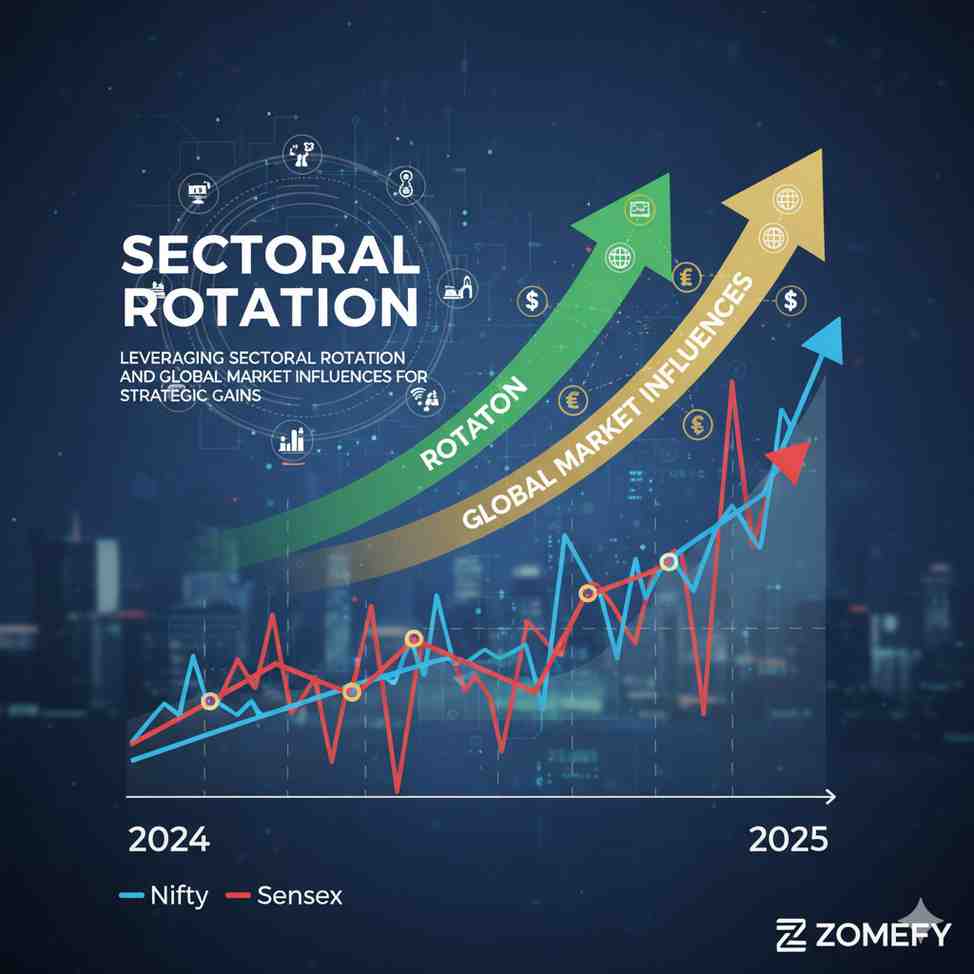RBI Monetary Policy 2025: How Repo Rate Decisions Will Shape Inflation and Liquidity in India
In October 2025, the Reserve Bank of India (RBI) maintained its key repo rate at 5.
RBI Monetary Policy 2025: How Repo Rate Decisions Will Shape Inflation and Liquidity in India
What You Can Do Next
- Read the full article for complete insights
- Save for later reference
- Share with others learning about this topic
Image not available
In October 2025, the Reserve Bank of India (RBI) maintained its key repo rate at 5.50%, holding the line after a series of earlier cuts that brought the rate to its lowest level since August 2022[1][3]. This decision, while widely anticipated, comes at a pivotal moment for India’s economy: inflation is projected to average just 2.6% in FY2025-26—well below the RBI’s medium-term target of 4%—while GDP growth forecasts have been raised to 6.8% for the year[2][3]. For Indian retail investors and financial professionals, understanding the interplay between RBI’s repo rate decisions, inflation, and liquidity is critical for portfolio construction, risk management, and identifying emerging opportunities. This article dissects the RBI’s latest monetary policy, explains how repo rate changes transmit through the economy, and provides actionable insights for navigating the current financial landscape. We’ll explore the implications for equities, debt, real estate, and banking sectors, with a focus on practical strategies and regulatory nuances unique to India.
Understanding the Repo Rate and Its Mechanism
The repo rate—currently 5.50% as of October 2025—is the rate at which the RBI lends short-term funds to commercial banks against government securities[1][4]. It is the central bank’s primary tool for managing liquidity and inflation. When the RBI cuts the repo rate, borrowing becomes cheaper for banks, which can then lower lending rates for businesses and consumers, stimulating economic activity. Conversely, a hike makes borrowing costlier, curbing excess liquidity and inflationary pressures[4].
In 2025, the RBI has already reduced the repo rate by 100 basis points (bps), with a notable 50 bps cut in June that surprised markets[1][2]. Alongside, the Standing Deposit Facility (SDF) and Marginal Standing Facility (MSF) rates stand at 5.25% and 5.75%, respectively, creating a corridor for short-term rates[1]. The reverse repo rate—the rate at which banks park excess funds with the RBI—is at 3.35%, influencing how much liquidity remains in the banking system[4].
How Repo Rate Changes Affect Different Market Segments
Major banks like SBI, HDFC Bank, and Axis Bank adjust their deposit and lending rates in response to repo rate changes. A lower repo rate compresses net interest margins (NIMs) but can boost credit growth. For instance, after the June 2025 cut, several banks reduced their RLLR by 25–40 bps, making loans cheaper for retail and MSME borrowers. However, if deposit rates fall slower than lending rates, savers may see lower returns on fixed deposits, pushing them towards mutual funds and equities.
Government securities (G-Secs) and corporate bonds react swiftly to repo rate signals. The 10-year G-Sec yield, a benchmark for pricing loans and bonds, tends to fall when the RBI cuts rates, boosting bond prices. Debt mutual funds, particularly gilt and dynamic bond funds, often outperform in a falling rate environment. However, with the RBI on hold, the scope for further capital gains may be limited unless another cut materializes[5].
Lower interest rates reduce the cost of capital for companies, supporting earnings growth and stock valuations. Sectors like real estate (DLF, Godrej Properties), automobiles (Maruti, Tata Motors), and consumer durables (Asian Paints, Havells) typically benefit from cheaper credit. However, export-oriented sectors (IT, pharma) face headwinds from a weaker rupee (₹87.5/USD in August 2025, with forecasts of ₹89.5 by year-end) due to US tariff pressures and global risk-off sentiment[5].
Affordable housing and commercial real estate see a demand boost when home loan rates fall. Developers like Mahindra Lifespaces and Brigade Enterprises may launch new projects, while REITs (Embassy Office Parks, Mindspace Business Parks) could attract more investor interest as yields compress.
Diversify across asset classes to balance rate sensitivity. Consider increasing allocation to equities in rate-sensitive sectors and select debt funds with moderate duration. Monitor bank announcements for RLLR revisions and RBI policy statements for shifts in stance.
Inflation Dynamics and RBI’s Policy Stance
Inflation in India has eased dramatically, with the RBI projecting an average of 2.6% for FY2025-26—significantly below its 4% medium-term target and the upper bound of its 2–6% mandate[2][3]. This disinflation is driven by softer food prices, stable crude oil, and prudent fiscal-monetary coordination. The RBI’s decision to hold rates reflects confidence in current inflation trends but also caution against potential external shocks, such as the recent 25% US tariff on select Indian imports and global financial volatility[1][3].
The RBI’s flexible inflation targeting framework, established under the RBI Act, 1934 (as amended in 2016), mandates it to prioritize price stability while supporting growth. The central bank’s current “neutral” stance provides flexibility to pivot if inflation or growth deviates from projections[2][3].
Case Study: Transmission of Past Rate Cuts
The RBI’s 100 bps rate cut in 2025 has had mixed transmission across the economy. While large corporates and prime retail borrowers have benefited from lower lending rates, MSMEs and lower-rated firms often face higher risk premiums, limiting the pass-through. For example, SBI’s RLLR fell by 35 bps post-June 2025, but many NBFCs and small finance banks have been slower to adjust, citing asset quality concerns.
Monitor transmission lags across lenders and sectors. Consider shifting deposits to banks with faster rate transmission and explore debt mutual funds that invest in higher-yielding corporate bonds where rate cuts are not fully passed on.
Liquidity Management and Systemic Risks
The RBI’s liquidity management framework is critical for ensuring smooth monetary transmission and financial stability. In 2025, the central bank has used a combination of rate cuts, CRR reductions, and OMOs to maintain adequate liquidity without stoking inflationary pressures[1]. The banking system’s liquidity position remains comfortable, with the RBI absorbing excess funds through reverse repo operations and injecting liquidity via repo as needed.
The RBI uses the Liquidity Coverage Ratio (LCR) and Net Stable Funding Ratio (NSFR) to ensure banks maintain sufficient high-quality liquid assets. Recent regulatory tweaks have allowed banks to include more government securities in their LCR computation, easing liquidity pressures.
Stay attuned to RBI’s liquidity operations and regulatory changes. Diversify across asset classes and geographies to mitigate currency and liquidity risks. Consider dynamic bond funds that can adjust duration based on liquidity conditions.
Investment Strategies for the Current Regime
- Overweight rate-sensitive sectors (banks, autos, real estate) if the RBI maintains or further cuts rates. Monitor large-cap banks (HDFC Bank, ICICI Bank) for stable earnings and dividend yields. - Underweight export-oriented sectors (IT, pharma) if the rupee remains weak and global demand softens. - Selectively invest in infrastructure and capital goods companies (L&T, Ultratech Cement) benefiting from government spending and cheaper credit.
- Lock in longer-duration deposits if another rate cut seems likely. - Prefer dynamic bond funds and corporate bond funds with moderate credit risk. - Avoid long-duration funds if inflation risks resurface or the RBI signals a hawkish turn.
- REITs and InvITs offer stable yields and diversification from traditional fixed income. - Gold ETFs can act as a hedge if global uncertainty spikes, though current low inflation limits upside.
- Rebalance portfolios regularly to reflect changing rate and liquidity conditions. - Hedge currency exposure for international investments or import/export-oriented businesses. - Monitor RBI policy statements for shifts in stance or forward guidance.
Ensure investments comply with SEBI guidelines, especially for mutual funds, AIFs, and PMS. Stay updated on tax implications of interest income and capital gains, particularly with respect to debt mutual funds and REITs.
Outlook and Actionable Takeaways
The RBI’s decision to hold the repo rate at 5.50% in October 2025 reflects a balanced approach to supporting growth while keeping inflation expectations anchored[1][3]. With inflation projected at 2.6% for FY2025-26 and GDP growth upgraded to 6.8%, the macroeconomic backdrop is favorable, but not without risks[2][3]. External headwinds—US tariffs, a weaker rupee, and global financial volatility—require vigilance, and the RBI’s “neutral” stance ensures it retains flexibility to respond to evolving conditions[3][5].
- Repo rate transmission is ongoing; monitor bank lending rates and bond yields for opportunities. - Inflation remains subdued, supporting real returns on fixed income and select equities. - Liquidity is ample, but regulatory and global risks necessitate diversification and active management.
- Stay informed on RBI communications, regulatory changes, and global macroeconomic trends.
Adopt a diversified, flexible investment strategy that balances growth, income, and risk. Use the current low-inflation, ample-liquidity environment to build core holdings in quality equities and debt, while maintaining liquidity for tactical opportunities. Regularly review asset allocation and risk exposure, and consult a financial advisor to align portfolios with personal goals and regulatory requirements.
Continue Your Investment Journey
Discover more insights that match your interests

Indian Startup IPOs 2025: Decoding Valuation Trends, Grey Market Premiums, and Listing Performances for Unicorns
The Indian startup ecosystem has entered a transformative phase in 2025, marked by a surge in Initial Public Offerings (IPOs) from unicorns and high-growth companies.

RBI Monetary Policy 2025: Navigating Neutral Repo Rates Amid Downward Inflation and Upgraded GDP Forecasts for Strategic Investing
The Reserve Bank of India (RBI) has maintained a neutral stance on monetary policy in 2025, holding the repo rate steady at 5.

Nifty and Sensex Performance 2025: Leveraging Sectoral Rotation and Global Market Influences for Strategic Gains
The year 2025 marks a pivotal phase for Indian equity markets, with the Nifty 50 and BSE Sensex navigating through complex dynamics shaped by sectoral rotations and global market influences.

Deglobalization & the New Investment Playbook: Navigating the Multipolar World of 2025
As we approach 2025, the global economic landscape is undergoing a profound transformation marked by deglobalization—the gradual retreat from the hyper-connected global trade and investment network...
Explore More Insights
Continue your financial education journey
